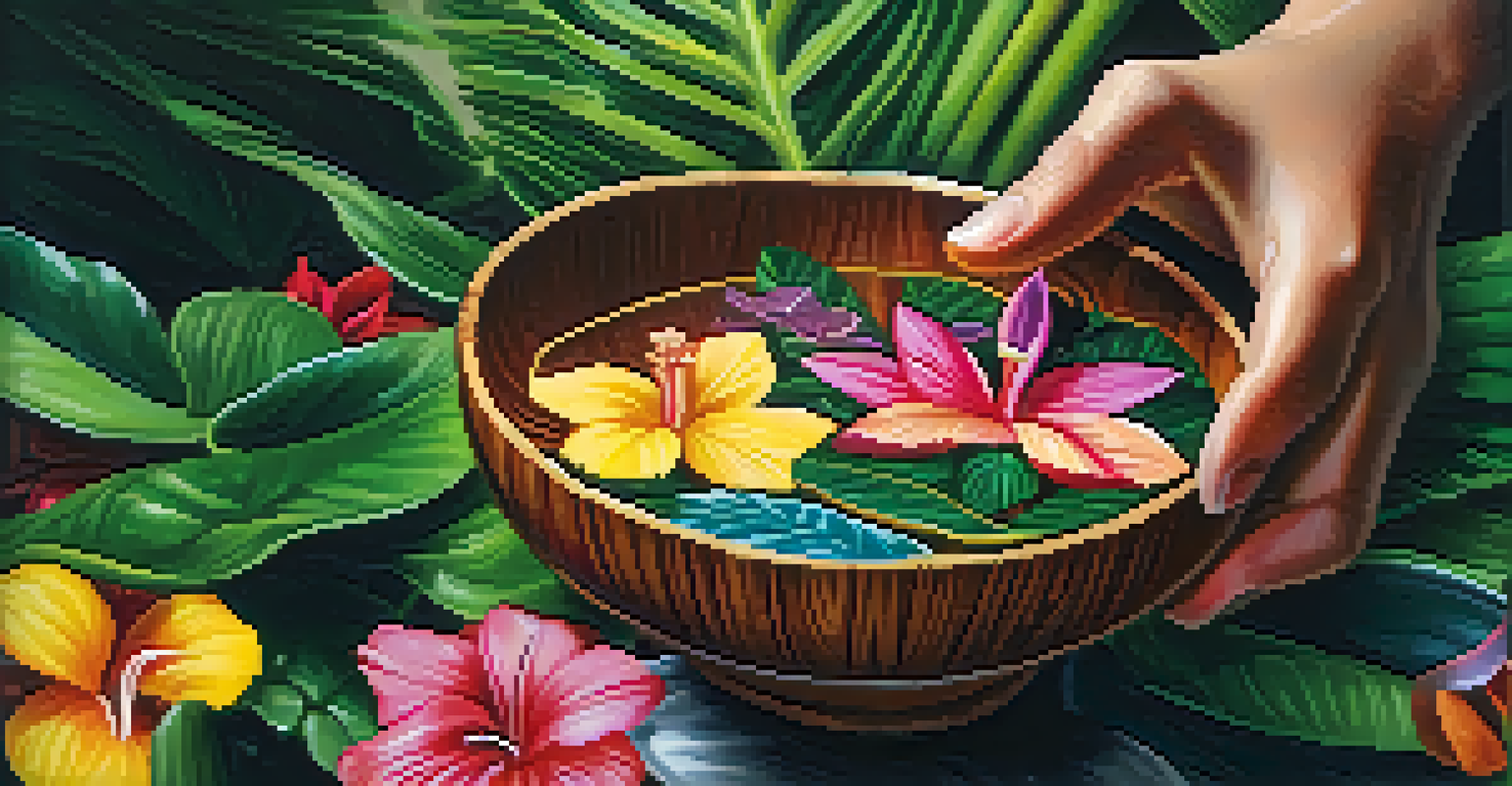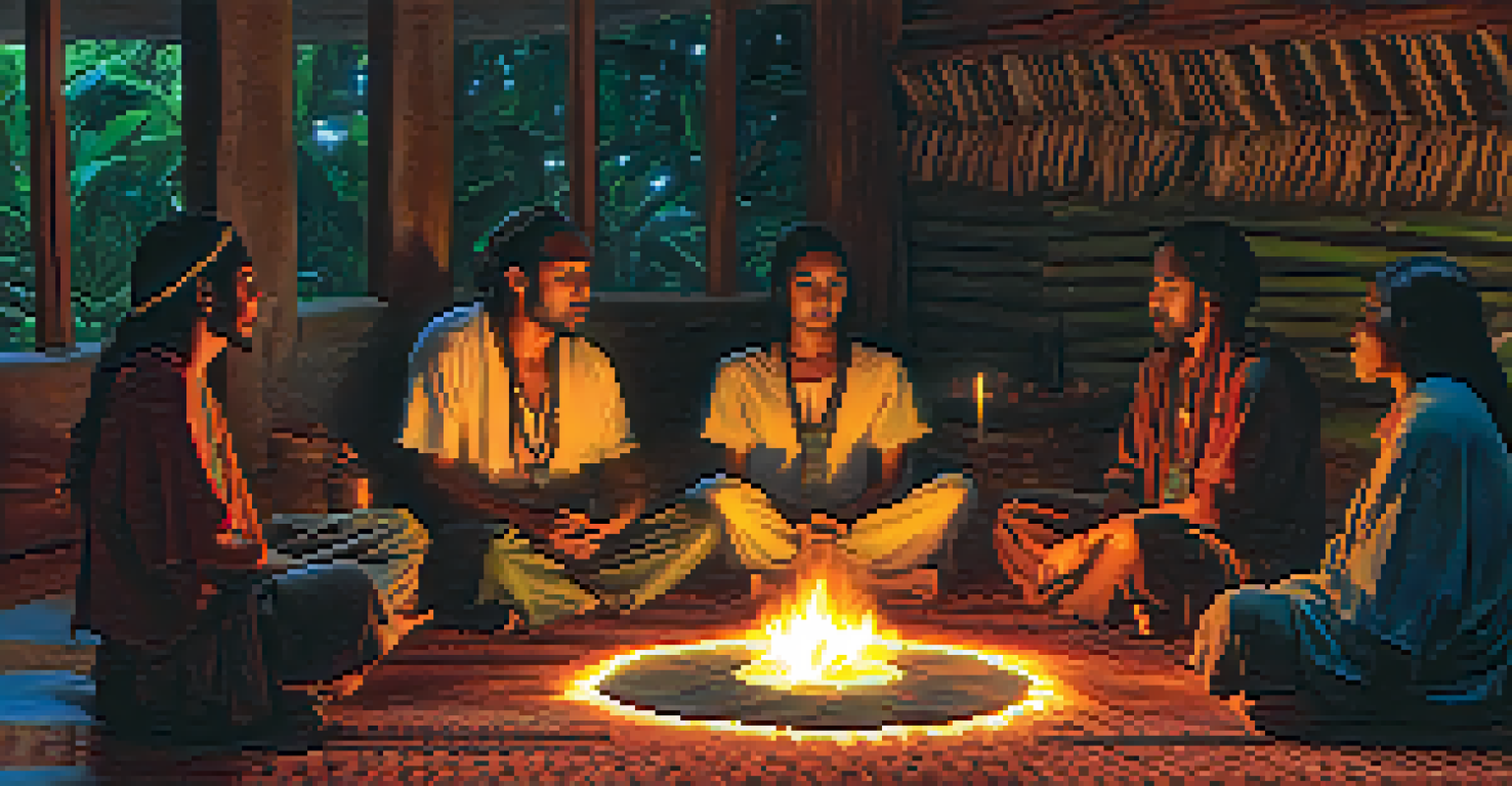Understanding Ayahuasca: A Journey Through Aging and Insight

What is Ayahuasca and Its Historical Significance?
Ayahuasca is a powerful brew made from the Banisteriopsis caapi vine and other plants, traditionally used by indigenous cultures in the Amazon. This sacred drink has been a part of spiritual practices for centuries, offering insights into the self and the universe. It’s known for inducing altered states of consciousness, allowing individuals to explore deep layers of their psyche. Understanding its historical significance helps us appreciate its role not just as a hallucinogen, but as a tool for healing and insight.
The greatest discovery of my generation is that a human being can alter his life by altering his attitude.
The indigenous tribes view ayahuasca as a means to connect with the spiritual world, often facilitated by a shaman. These shamans guide participants through their journeys, using their knowledge to interpret visions and experiences. This connection to tradition adds a layer of respect and understanding to the practice, emphasizing that it is not just a recreational drug, but a profound cultural experience. Engaging with ayahuasca invites us into a world where healing and insight are intertwined with nature and spirituality.
As ayahuasca gains popularity worldwide, it often faces scrutiny and misunderstanding. However, it is essential to recognize that its benefits extend far beyond mere escapism. The historical context enriches our understanding, reminding us that this ancient practice carries wisdom that has been passed down through generations, offering a unique perspective on aging and personal growth.
The Science Behind Ayahuasca: What Happens in the Brain?
When you ingest ayahuasca, its active compounds, primarily DMT (dimethyltryptamine), interact with serotonin receptors in the brain. This interaction can lead to vivid hallucinations and profound emotional experiences, often likened to a deep introspective journey. Research suggests that these experiences can promote neuroplasticity, the brain's ability to reorganize itself by forming new neural connections. This is particularly relevant for older adults seeking fresh insights and perspectives as they navigate the complexities of aging.

During an ayahuasca ceremony, participants often report experiencing significant emotional releases, which can help in processing past traumas or unresolved feelings. This cathartic experience can lead to a renewed sense of clarity and understanding, potentially aiding in mental health issues like depression or anxiety. Moreover, as we age, the ability to process and understand our emotions becomes crucial, making ayahuasca a compelling option for many seeking personal growth.
Ayahuasca's Spiritual and Healing Roots
Ayahuasca is traditionally used by indigenous cultures for spiritual healing and insight, connecting individuals with nature and their inner selves.
It's fascinating to consider how a single experience with ayahuasca can create lasting changes in one's outlook on life. As the brain rewires itself, individuals may find they approach challenges with renewed vigor and wisdom. This scientific perspective underscores the potential for ayahuasca not just as a temporary escape, but as a genuine pathway to deeper insights, especially as we journey through the later stages of life.
Aging and the Search for Meaning: How Ayahuasca Fits In
As we age, many of us grapple with existential questions about purpose and meaning. Ayahuasca can serve as a catalyst for exploring these profound inquiries, prompting introspection that might lead to significant personal revelations. For some, the experiences uncork a flood of memories and feelings previously tucked away, illuminating paths to understanding one's life choices. This process can be particularly healing for older adults looking to integrate their life experiences into a cohesive narrative.
The wound is the place where the Light enters you.
The journey through ayahuasca often mirrors the stages of aging, where one confronts both the light and shadow of their past. Participants might find themselves reflecting on relationships, regrets, and achievements, ultimately leading to greater acceptance and peace. This alignment between aging and the ayahuasca experience fosters a unique opportunity for growth, allowing individuals to embrace their life stories fully. It’s a chance to transform perceived limitations of aging into a rich tapestry of insights.
Moreover, the sense of community during ayahuasca ceremonies can alleviate feelings of isolation that often accompany aging. Sharing experiences with others can foster connection and support, reminding participants that they are not alone in their quest for meaning. Through this lens, ayahuasca becomes more than just a personal journey; it’s a collective exploration of what it means to grow older and wiser together.
Preparing for an Ayahuasca Journey: What to Expect
Preparing for an ayahuasca ceremony involves both physical and mental readiness. Participants are usually advised to follow a specific diet in the days leading up to the experience, avoiding processed foods, alcohol, and certain medications that could interfere with the brew's effects. This preparation is not just about the physical body; it also sets the stage for a more profound psychological experience. Mental preparation, such as setting intentions for the journey, can significantly enhance the outcome.
During the ceremony, participants typically find themselves in a safe and supportive environment, often guided by an experienced shaman. The setting plays a crucial role in the experience, as it allows individuals to feel secure enough to explore their inner landscapes. Expect the unexpected; emotions may surface, and visions may challenge your understanding of reality. Embracing this uncertainty is part of the journey, and being open to whatever unfolds can lead to transformative insights.
Scientific Insights on Ayahuasca
Research indicates that ayahuasca can promote neuroplasticity and emotional healing, making it a valuable tool for personal growth, especially in older adults.
Post-ceremony, many people experience a period of reflection, where the insights gained during the journey can be integrated into everyday life. This integration phase is essential for making sense of the experience and applying newfound wisdom. It’s not uncommon to feel a sense of clarity or even a shift in perspective following the journey, as if pieces of a puzzle have finally come together. Preparing for ayahuasca is not just about the ceremony itself, but about the entire process of growth it inspires.
The Role of Integration After the Ayahuasca Experience
Integration is a crucial aspect of the ayahuasca experience that is often overlooked. After a profound journey, individuals must find ways to incorporate the insights gained into their daily lives. This might involve journaling, therapy, or engaging in support groups where participants can share their experiences. Just as aging involves learning from past experiences, integration allows one to translate those lessons into actionable changes moving forward.
Many find that the insights gained through ayahuasca can lead to a shift in priorities, prompting them to focus on relationships, health, or passions they may have neglected. This newfound clarity can empower individuals to make meaningful changes in their lives, enhancing their overall well-being as they age. It's a reminder that life is a continuous journey of learning and growth, where every experience adds depth to our understanding.
Furthermore, the integration process can foster resilience, helping individuals navigate life’s challenges with greater ease. As we age, cultivating resilience becomes increasingly important; it's about adapting to change and finding strength in vulnerability. By actively engaging in integration, individuals can turn their ayahuasca experiences into a lifelong toolkit for personal development, enabling them to embrace the aging process with grace and insight.
Ayahuasca and Mental Health: A Healing Perspective
Research into ayahuasca’s effects on mental health is gaining momentum, showcasing its potential benefits for various conditions, including depression, anxiety, and PTSD. Many participants report significant emotional healing and clarity after their experiences, often describing a sense of release from burdens they've carried for years. This therapeutic potential is particularly relevant for older adults who may be grappling with loss, loneliness, or unresolved trauma as they age.
The healing properties of ayahuasca can be attributed to its ability to facilitate deep emotional processing. During ceremonies, participants often confront painful memories and feelings, which, when processed, can lead to a lighter emotional state. This catharsis can be incredibly liberating, creating space for joy and acceptance in life’s later years. It's a testament to the idea that healing is possible, no matter where we are on our life journey.
Cultural Sensitivity is Crucial
Engaging with ayahuasca requires respect for its indigenous roots and traditions, emphasizing the importance of authentic experiences and ethical practices.
However, it’s essential to approach ayahuasca with caution and respect, particularly for those with pre-existing mental health conditions. Professional guidance and support are crucial to ensure a safe and beneficial experience. When approached thoughtfully, ayahuasca can be a powerful ally in the quest for mental health, offering insights that can help individuals navigate the complexities of aging with a renewed sense of purpose and hope.
Cultural Considerations: Respecting the Traditions of Ayahuasca
As ayahuasca becomes more popular in Western cultures, it’s vital to approach its use with cultural sensitivity and respect. The practices surrounding ayahuasca are deeply rooted in indigenous traditions, and engaging with them requires an understanding of their significance. It’s essential to seek out authentic experiences led by qualified shamans who honor the cultural context and spiritual aspects of the brew. This respect helps preserve the integrity of the practice while benefiting from its insights.
Cultural appropriation is a significant concern in the ayahuasca community, where individuals must be mindful of their privilege and the impact of their actions. Engaging with ayahuasca is not just about personal gain; it’s about building relationships with the indigenous communities that have safeguarded these traditions for generations. Supporting these communities through ethical practices ensures that the benefits of ayahuasca can be shared while honoring its roots.

Ultimately, understanding the cultural dimensions of ayahuasca enriches the journey and enhances the insights gained. It reminds participants that they are part of a larger narrative, one where respect and gratitude play a vital role. By honoring the traditions of ayahuasca, individuals can cultivate a deeper appreciation for the wisdom it offers, blending personal growth with a commitment to cultural integrity.